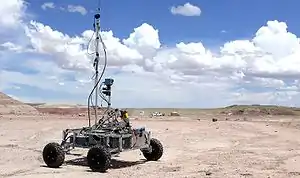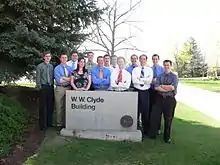BYU Mars Rover
The BYU Mars Rover is a student designed, built and run project overseen and funded primarily by the Mechanical Engineering, Electrical Engineering and Physics departments at Brigham Young University. The rover competes annually in the University Rover Challenge (URC) near Hanksville, Utah at the Mars Desert Research Station, and is currently being evaluated for research use.

History
The BYU Mars Rover project is currently in its twelfth year, after being started by BYU Physics Professor Dr. David Allred when he announced the upcoming URC in his second semester physics class.[1]
2007
After deciding to compete in the first URC, and being funded primarily by the BYU Physics Department and Dr. Allred, the team began construction on a simple rover design, using 3/4" square aluminum tubing for the chassis, and a four-wheel drive, skid steer type drivetrain using brushless motors. The rover also had stereo video transmitted over 900 MHz analog video links.[2][3][4]
The first year the BYU rover took second place at the competition, coming in behind the University of Nevada, Reno rover, and ahead of Penn State and UCLA.[5][6]
2008
For the 2008 season, the BYU rover was completely redesigned and rebuilt from scratch, with a completely new drivetrain, a suspension, and a custom designed and built robotic arm. Unfortunately, the redesign left no time for testing, and the rover did not complete its first drive until the team was actually at the event.
After solving computer issues the first day of events, the BYU rover competed in the Soil Science task on the morning of the second day, but broke their drivetrain within minutes of leaving the start gate. This failure led the BYU team to finish in fifth place.[7][8]
2009

After the past year's mechanical failures and software issues, the rover was modified, as the team felt that the basic design of the rover was sound, it just needed revision. As such, the chassis was kept mostly the same, but a completely new suspension was designed and built, and a new drivetrain was selected, as well as switched the operating system on the rover from Windows XP to Debian GNU/Linux.
Another goal of the team was to test the rover a month before the URC, a task that was accomplished with the drivetrain and other basic controls, but not with video or the arm.
At the event, the rover was able to actually compete in all of the tasks for the first time, with no major failures. The primary limitations were radio range, and limited testing with the robotic arm. As such, the rover did well at competition, finishing in second place.[9][10]
2017
In 2017, the science team scored a perfect 100, which helped propel the team into what was thought to be third place. Several weeks later it was announced that there was a calculation error in the point tallies for each team. This miscalculation caused the team to move to fourth place, by a small margin.[11]
2018
In 2018, BYU faced some controversy in the Extreme Delivery and Retrieval task. Seeking to drop off a payload, they went up a ravine where they tipped over, forcing an intervention and subsequent loss of 20% of their points. This kept them from earning the 40 points needed to pass to the second round of the task, where more points could be earned. However, after deliberation, the judges decided that a bad GPS point had led them off course and caused the intervention. BYU was then allowed to attempt the second round, earning 10 more points before losing the rover over a cliff. Luckily, a quick-thinking student dove to catch the rover, falling with it and preventing it from rolling and damaging itself irreparably.
The judges increased the difficulty of the other tasks significantly, especially Autonomous Traversal. However, the BYU Mars Rover successfully traversed five of the eight possible legs earning a competition high 55. Most teams didn't earn any points in the task, leading to a competition average of 5.6. For comparison, the average Autonomous Traversal score in 2017 was 19.6, and seven teams scored 55 or higher, including one 100.[12][13] This, along with a nearly perfect Science Cache score, pulled BYU up to 5th place.
Technical overview
Mechanical systems
As of 2018, the BYU Mars Rover has a rocker-bogie design with six wheels, each of which can be independently controlled. The rover arm has 6 DOF.
In 2009, the BYU Mars Rover was a four-wheel drive, skid steer type vehicle, approximately 36" long, 40" wide, and 20" tall (excluding antenna and camera mast). Each wheel is approximately 12" in diameter, and is powered by a brushless electric motor and planetary gearbox. The suspension is a fully independent A-arm design, with CNC milled A-arms, and is well integrated into the rover chassis in order to reduce weight and complexity.
The rover arm is a student designed and built 5 degree of freedom robotic arm using high resolution optical encoders and high torque planetary gear motors as well as timing belt gearing.
Control systems
The rover is controlled using a variety of off the shelf computing platforms. The primary computer is a 1 GHz Intel single-board computer (SBC) running Ubuntu Linux and connected to the communications radios over Ethernet. In addition, the arm and servo control is handled by an ARM SBC running at 500 MHz and a Lynxmotion 32 output servo controller.
The rover uses a 900 MHz radio with a theoretical throughput of 54 Mbit/s and an output power of up to 700 mW. Both the base station and rover side radios are connected to omnidirectional antennas.
Computer Vision
The rover uses a ZED stereo camera for image recognition, while a RPLidar A2 senses nearby obstacles.
GPS/IMU
An InertialSense µINS Development Kit provides position, heading, velocity, and acceleration data using GPS and IMU data.
Awards
- Second Place, 2007 University Rover Challenge – Rover 1
- Fifth Place, 2008 University Rover Challenge – Rover 2
- Second Place, 2009 University Rover Challenge – Rover 2.1
- Fourth Place, 2010 University Rover Challenge – Rover 2.2
- Fourth Place, 2011 University Rover Challenge – Rover 2.2.1
- Second Place, 2012 University Rover Challenge – Rover 3.0
- Third Place, 2013 University Rover Challenge-
- Fourth Place & Judges Award, 2014 University Rover Challenge-
- Second Place, 2015 University Rover Challenge
- Fourth Place, 2017 University Rover Challenge
- Fifth Place, 2018 University Rover Challenge
References
- BYU land rover explores planet Earth – in 3-D, Salt Lake Tribune, June 3, 2007, 6049690
- Stuart, Elizabeth (3 June 2007). "BYU students look to explore Mars". DeseretNews.com. Retrieved 24 January 2019.
- Lusk, Brittani (31 May 2007). "BYU students to compete in Mars challenge". Daily Herald. Retrieved 24 January 2019.
- Morgan, Meghan. "BYU Engineers Enter Competition to Design Mars Rover". BYU. Archived from the original on 15 September 2007.
- http://www.marssociety.org/portal/c/urc/2007-urc-archive/announcements/UNR%20Wins%20Inaugural%20University%20Rover%20Challenge.pdf/?searchterm=2007%20URC%5B%5D
- Race to Mars Miniseries, Daily Planet, Discovery Channel Canada
- http://www.marssociety.org/portal/Members/schnarff/URC2008Results/?searchterm=2008%20URC%5B%5D
- Hadhazy, Adam (18 June 2008). "Colleges Battle It Out in Mars Rover Competition". Scientific American. Retrieved 24 January 2019.
- Jones, K. C. (1 June 2009). "York U Wins Mars Rover Challenge". Information Week. Archived from the original on 13 June 2011.
- Kirk, Alex. "York University Captures Title at Third Annual University Rover Challenge". Archived from the original on 2009-06-05. Retrieved 2009-06-04.
- "URC2017 Scores - University Rover Challenge". urc.marssociety.org. Retrieved 2019-02-09.
- "University Rover Challenge 2017 Scores". urc.marssociety.org. Retrieved 24 January 2019.
- "University Rover Challenge 2018 Scores". urc.marssociety.org. Retrieved 24 January 2019.